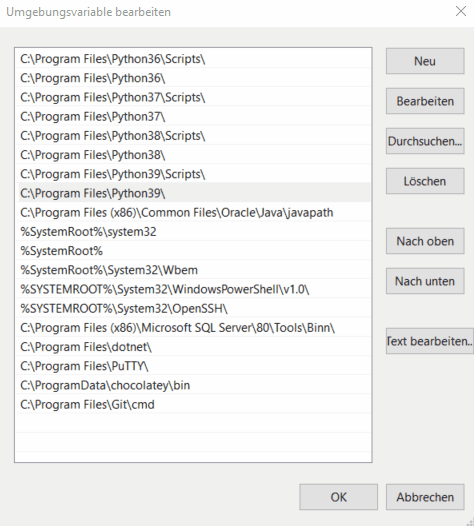Requirements¶
OTVision is designed to run on most modern operating systems (Windows, Linux and Mac). However, a few prerequisites are required before installing OTVision.
Hardware prerequisites¶
OTVision runs on modern desktops and laptops (e.g. Intel i5+ of the last few generations, AMD Zen chips or Apple Silicon processors and 8 GB RAM).
If you want to detect road users in videos with OTVision on a regular basis, we strongly recommend purchasing a powerful desktop computer or workstation (>= 8+ cores, >= 16 GB RAM) with a Nvidia graphics card (>= GeForce 10XX Series, better is usually faster). Make sure that the Nvidia drivers as well as the NVidia CUDA Toolkit are installed and up-to-date to get the best performance.
Apple Neural Engine
Accelerated detection using the Apple Neural Engine is not yet supported. Detection on Apple silicon chips is currently performed using CPU only.
Software prerequisites¶
Python 3.10¶
OTVision is based on Open Source Python packages. Thus, it runs on Windows, macOS and Linux systems after setting up the environment correctly. Consequently, Python needs to be installed on your system. Currently OTVision runs best on Python 3.10. An instruction on how to do that on a Windows system can be found below.
What if I want to use another Python version?
Python 3.10 is the version we are currently testing against and providing installation scripts for. Other Python versions might work as well, but are not currently tested. In any case, you will have to install the requirements manually or adapt the installation scripts accordingly.
If not done yet, install the latest 64-bit version of Python 3.10 via Windows installer (www.python.org/downloads).
Please make sure to check the following boxes during installation:
- Add Python to PATH
- Install pip
- All advanced options
What if I already have another Python version installed?
In addition, also install Python 3.10. On most operating systems you can choose
the python version to use by using python-3.10oder python3.10 styled commands.
On Windows, it is also possible to change the default Python interpreter by changing the order of the system-wide environment variables (move Python310 and Python310\Scripts to the top, see animation below).
This is necessary e.g. if you have already installed Python 3.10, but another Python version is your default because you installed it (e.g. 3.11).

To check your Python installation, run the the follwing commands in a command terminal:
python --version
If Python 3.10.x is returned, you are good to go!
Depending on the Linux distribution you are using, Python 3.10 might not be the pre-installed version. You can check if (and which sub-version of) Python 3.10 is installed by running the following command in the terminal:
python3.10 --version
If necessary, install Python 3.10 manually using additional sources. Since the sources might differ depending on the Linux distribution you are using, we kindly ask you to use a search engine for a detailed instruction on how to install Python 3.10 manually for your distribution.
In any case, please make sure that you also have the python virtual environment
package python3.10-venv installed.
Depending on the macOS version you are using, Python 3.10 might not be the pre-installed version. You can check if (and which sub-version of) Python 3.10 is installed by running the following command in the terminal:
python3.10 --version
If necessary, install Python 3.10 as described below.
Homebrew¶
We recommend installing Python using Homebrew:
brew install python@3.10
Manual installation¶
Alternatively, you can download a macOS installer for python 3.10 from python.org.
Check installation¶
Again, run this command in the terminal:
python3.10 --version
ffmpeg¶
If you want to use videos recorded by OTCamera with OTVision, you need to convert the videos to .mp4 files first. For the conversion, we use the Open Source software ffmpeg.
Before using the convert.py script, make sure that ffmpeg is installed and available on the whole system:
To install ffmpeg on your Windows system, please perform the following steps:
- Download the file
ffmpeg-git-full.7zfrom gyan.dev. - Unzip this file by using any file archiver such as 7zip in a folder of
your choice (e.g.,
C:\ffmpeg). -
Now, open a Command Prompt with administrator privileges and set the environment path variable for ffmpeg:
setx /m PATH "path_to_your_ffmpeg_folder\bin;%PATH%"where
path_to_your_ffmpeg_folderrepresents the folder that you have ffmpeg unzipped in.If you unzipped to
C:\ffmpeg, for example:setx /m PATH "C:\ffmpeg\bin;%PATH%" -
Restart your computer and verify the installation by running
ffmpeg -version
Ubuntu repositories¶
If you use Ubuntu, you can install ffmpeg using the official Ubuntu repositories.
sudo apt install ffmpeg
Manual installation¶
For the manual installation of ffmpeg on Linux or if you use another distribution, please refer to the instructions on the developers website.
Homebrew¶
For the installation using Homebrew, use the following command in the terminal:
brew install ffmpeg
Manual install¶
For the manual installation of ffmpeg on macOS, please refer to the instructions on the developers website.
Nvidia CUDA (optional)¶
If you intend to use OTVision on a Windows or Linux PC with a modern Nvidia graphics card, download and install version 11.6 of the NVIDIA Cuda Toolkit.